Okra: Africa's Delicious Gift to the World
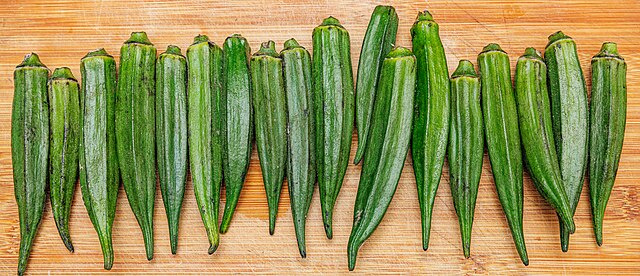
By: Habeeb Salloum/Arab America Contributing Writer
Once only a soul food in the southern American states, okra is slowly becoming familiar in all parts of North America. Also, known as bamya, gumbo and ladies’ fingers, it has been for hundreds of years a popular vegetable, especially in Africa, India, and the Middle East. With the discovery of the ‘New World’, its consumption as an important food spread to the Caribbean, Central America and the deep south of the U.S.A. Today, fresh, canned and frozen, okra is featured on most supermarket shelves. As year after year more people become aware of its deliciously unique taste, it has gradually crept into the North American kitchen.
Once treasured as a delicacy in Moorish Spain, this small attractively shaped vegetable had its origin in Ethiopia. From that ancient land, it travelled north to the Mediterranean shores and east to India. The African Arabs who called it uehka, from which the name okra could have been derived, carried it to West Africa and the Iberian Peninsula. In Spain after the Christian conquest, it fell out of favour, but in much of Africa and the eastern Mediterranean it thrived and became a popular food.
In the 17th century okra came to North America from West Africa, along with the slaves brought by the French to Louisiana. In the ensuing years it was extensively cultivated in the Mississippi delta – its original American home. Here, it not only became a favoured food, but also, for some unexplained reason, developed a reputation as a love vegetable.
Widely grown in a number of tropical and sub-tropical lands, okra flourishes in areas with long hot, but not too wet summers. It is the fruit of a decorative annual belonging to the mallow family of the genus hibiscus, closely related to the cotton plant.
Growing from 2 to 10 feet high with heart-shaped leaves and crimson centred yellow
flowers, a magnet for bees, the plant is cultivated mainly for its immature pods. These are tapering, ten-angled capsules with five or more sections filled with seeds. Dark green in colour, they can reach a length of 12 inches. The plants are prodigious yielders and must be picked every few days unless the pods are to be harvested for their seeds.
If they are to be used in cooking, the pods must be gathered before they mature on the plant and become overly tough and fibrous. They are at their best when tender, fresh and crisp – usually less than 3 inches long. If the pods turn yellowish-spotted brown, they are over-mature and not fit for the pot.
Besides the pods, the leaves of the okra plant are, at times, cooked as greens and the dried seeds can be utilized as an alternative to dried beans. They can also be ground into a high-protein food or roasted and ground as a pleasant-tasting coffee substitute.
When the pods ripen on the plant there is an extraordinary increase in the protein content of the seeds. In addition to some minerals and vitamins, they contain as much protein as soybeans. However, their balanced amino acid pattern makes more of this essential nutrient available to the body.
The tender pods, used in cooking, are high in calcium and contain some potassium and a modest amount of vitamins A & C. To retain these healthful elements, they must be cooked when fresh. Okra spoils easily and will only keep a day or two in a cool room. On the other hand, if placed in plastic bags, the pods can be stored for up to 2 weeks in a refrigerator.
In the bygone ages, when okra was to be preserved for long periods of time, the pods were dried in the sun. Today, except for the countries in Africa and Asia where drying is still practised, they are canned or frozen. The dried product which can be found in most Middle Eastern markets and some health stores is much better than the canned variety. Canning brings out the worst in this vegetable. It destroys the pod’s dark green colour and brings out their sticky-like unappetizing texture.
By far the best method of preservation is freezing. Only the young delicate pods should be chosen. Before being frozen, the stems must be removed without breaking the crowns. The pods are then to be blanched in boiling water for 2 minutes and allowed to cool before being packed in plastic bags and frozen. On the other hand, frozen okra, imported in winter from Central America and Mexico, is available year-round in almost every North American supermarket.
Okra can be baked, boiled, or fried. However, it should never be cooked in aluminum, iron or tin utensils as the metal is likely to discolour and darken the pods. It is best cooked in enameled or Pyrex pans and pots.
Great care must be taken in cooking the fresh pods. The mucilaginous juice of okra gives it a slimy texture. Hence, it must be cooked properly, or it will become a gluey mess and an unpopular dish.
To eliminate this problem, the pods should be washed well, and the stems trimmed, then soaked and stirred a few times for one hour in l cup of vinegar with a little water to about 2 pounds okra. The vinegar can then be discarded, and the okra allowed to dry before use. This operation does away with discoloration and stops the pods from opening. The frozen product needs no such preparation. After thawing, the pods are ready for cooking.
Okra is often used for flavouring and as a food thickener. Its subtle distinctive eggplant-like flavour makes it an excellent ingredient in soups. The special gumminess of this vegetable produces an ideal thick and rich broth. Hence, it is commercially grown for manufacturers who make it into a powder for thickening soups.
In addition to its use in soups, okra is used in a number of other ways in the kitchen. The pods can be stewed by themselves with herbs and spices or cooked with chicken, fish or meat, and in combination with a number of vegetables like chickpeas, corn, onions, fresh peppers and tomatoes. However, except for these vegetables, okra does not blend well with most other vegetables and, hence, is hardly ever prepared in stews with other garden produce. In almost all okra dishes, lemon juice is a desirable ingredient. It always brings out the delectable flavour of the okra.
Although not essential in the preparation of some stews, the secret of cooking okra is to sauté the pods at the beginning of cooking. When being sautéed the pods should be stirred gently so that they do not break. If they open, the dish will have a slimy texture. Also, as little water as possible helps in preserving the taste and the attractiveness of the pods.
In the southern U.S.. where okra is very popular as a soul food, it is usually dipped in cornmeal and fried or made into gumbo – a dish consisting of okra, chicken, meat, or shellfish stewed with herbs and spices. These foods are similar to a good number of dishes made from this delicious vegetable in the Middle East and Africa. The following dishes are a minuscule selection based on versions of the recipes from these ancient lands.
Okra and Garlic Appetizer
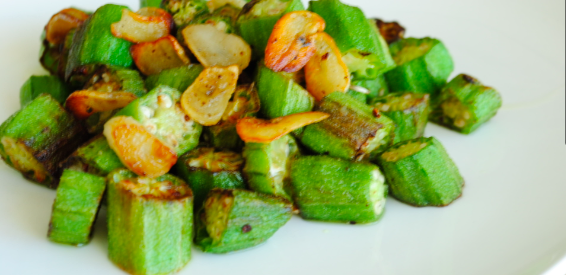
Serves 4
4 tablespoons cooking oil
1 package frozen okra (10.6 oz 300 g), thawed
1/2 head garlic, crushed
1/4 cup olive oil
1/4 cup lemon juice
1/2 teaspoon salt
1/4 teaspoon black pepper
l/8 teaspoon cayenne
2 tablespoons finely chopped coriander (cilantro)
Heat oil in a frying pan, then sauté okra over medium heat for 10 minutes or until the pods begin to brown, then transfer to serving platter and allow to cool.
In the meantime, prepare a sauce by placing remaining ingredients in a blender, then blending for about 1 minute. Spread the sauce evenly over the okra, then serve.
Okra Soup
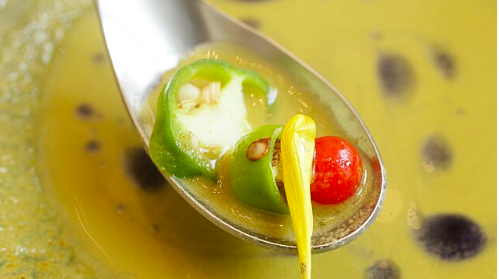
Serves 8 to 10
4 tablespoons butter
1-pound boneless chicken, cut into small pieces
2 medium onions, finely chopped
4 cloves garlic, crushed
1 small hot pepper, seeded and finely chopped
2 cups stewed tomatoes
6 cups water
1 1/2 teaspoons salt
1 teaspoon cumin
1/2 teaspoon powdered ginger
1/2 teaspoon black pepper
1 package. frozen okra (10.6 oz 300 g), cut into small pieces
2 tablespoons finely chopped coriander (cilantro)
In a saucepan, melt the butter, then sauté chicken over medium heat for 5 minutes. Add onions, garlic, and hot pepper, then stir-fry for further 10 minutes. Add remaining ingredients, except coriander, then bring to boil. Cover, then cook over medium heat for 1 hour or until chicken is well cooked, stirring occasionally. Stir in coriander leaves, then serve hot.
Okra with Tahini

Serves 4
1/2 cup finely ground breadcrumbs
1/4 teaspoon black pepper
1/4 teaspoon cumin
l/8 teaspoon cayenne
1/2 cup cooking oil
1-pound fresh okra, washed, then stemmed and sliced in half lengthwise
1 egg, beaten with a little water in a small bowl
2 tablespoons tahini (sesame seed paste)
2 tablespoons lemon juice
1 clove garlic, crushed
1/2 teaspoon salt
4 tablespoons water
In a bowl, combine breadcrumbs, pepper, cumin, and cayenne then set aside on a plate beside bowl with beaten egg bowl.
Dip okra in egg and roll in breadcrumbs.
In a frying pan, heat oil over medium and fry okra about 5 minutes or until okra becomes golden, adding more oil if necessary. Remove with a slotted spoon then place on a serving platter.
Thoroughly combine remaining ingredients, then spoon evenly over the okra and serve immediately.
Chickpea and Okra Stew
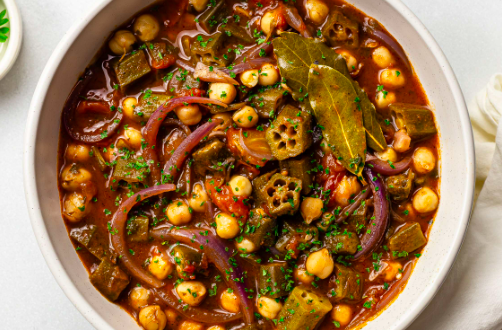
Serves 4
4 tablespoons olive oil
2 medium onions, finely chopped
6 cloves garlic, crushed
1/2 small hot pepper, seeded and finely chopped
1 package frozen okra (10.6 oz 300 g), thawed
1 can chickpeas (19 oz 540 ml), with its water
1/2 cup water
3/4 teaspoon salt
1/2 teaspoon cumin
1/2 teaspoon ground coriander
1/2 teaspoon ground mustard
1/2 teaspoon black pepper
4 tablespoons lemon juice
In a saucepan, heat the oil over medium-low, then sauté onions, garlic and hot pepper for 10 minutes. Add okra, then gently stir-fry for further 5 minutes. Add remaining ingredients, except lemon juice then bring to a boil. Simmer over medium-low heat for about 25 minutes, adding a little more water, if necessary, then stir in lemon juice and serve hot or cold with cooked rice.
Seafood and Okra Casserole
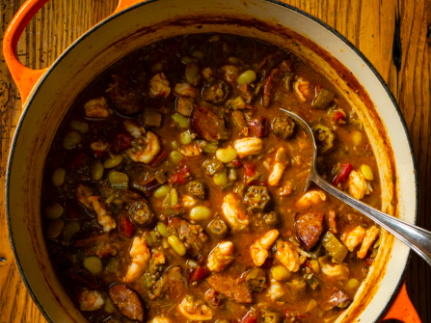
Serves 4 to 6
4 tablespoons butter
6 cloves garlic, crushed
1/2 small hot pepper, seeded and finely chopped
I package frozen okra (10.6 oz 300 g), thawed
1 can crab meat (4.23 oz 120 g), drained
1 can clams (5 oz 142 g), drained
2 cups stewed tomatoes
1/2 teaspoon salt
1/2 teaspoon ground coriander seeds
1/4 teaspoon cumin
1/4 teaspoon black pepper
1/2 cup water
4 tablespoons lemon juice
In a frying pan, melt the butter then sauté garlic and hot pepper over medium for 3 to 4 minutes. Transfer frying pan contents to a casserole then gently stir in remaining ingredients, except lemon juice. Cover and bake in a 350° F preheated oven for 1 hour, then stir in lemon juice and serve hot with cooked rice.


